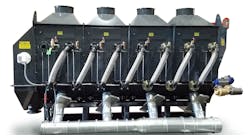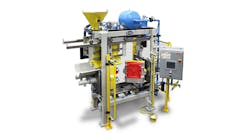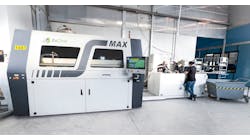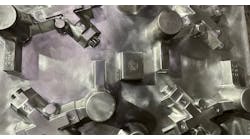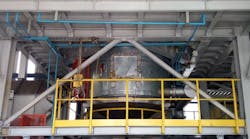Latest from Molds/Cores
Fata Aluminum recently installed a green sand regeneration plant at Tupy green-sand iron foundry in Saltillo, Mexico. As is known, the thermal/mechanical regeneration of foundry sand, especially for cast iron foundries that operate with green sand plants, makes it possible to reduce the purchase of new sand. This reduces the transport of sand to and/or scrap from the foundry.
Aside from these essentially economical/environmentally friendly advantages, regeneration also makes it possible to carefully monitor the sand used by the foundry, and therefore its quality, as the features of regenerated sand are kept constant thanks to the treatment which the sand undergoes in the regeneration plant itself.
The regeneration technology, involving a mixed mechanical/thermal/mechanical treatment, was developed by Fata Aluminum in the 1980s and has been adopted by cast iron foundries like Cifunsa and Teksid, with plants ranging in capacity from 5 to 25 mt/hr. The Tupy Saltillo regeneration plant has an input capacity of approximately 13 mt/hr of product to be treated, and produces about 10 mt/hr of regenerated sand used to manufacture cores.
The plant entered the full production stage in May 2015, processing excess sand from green sand molding lines. The material to be processed is first crushed to a maximum size of 3 mm, and then metal is separated.
The sand undergoes a first mechanical treatment carried out by a pneumatic attritor (designed and built by Fata Aluminum) in order to remove most of the bentonite in the sand to be processed.
The next step is thermal treatment, with a sand regeneration furnace that operates on the principle of the fluid bed, heated by natural gas, with a calcinated sand/air heat-recovery device. Hot sand leaving the calcination furnace drops by gravity into a heat exchanger consisting of two overlapping fluid beds, where it meets a backflow of fluidization/combustion air of the furnace.
Specific valves, without moving parts and therefore suitable for high-temperature operation, allow the sand to pass from one fluid bed to the one below, forcing the combustion/fluidization air to cross the two thermal exchange fluid beds. In this way, the air is preheated before it arrives at the calcination chamber, to a temperature very close to that of the calcinated sand, greatly reducing gas consumption. For example, with a calcination temperature of 700°C, the air is preheated beyond 600°C.
Furthermore the calcinated sand definitely cools down, thus reducing the size of the final fluid bed cooler and the relative demand for cooling water circulating in its tube bundle. Again, as an example, with calcination temperature of 700°C, the sand is cooled to a temperature of about 300-350°C.
Operational safety is provided by the two pilot burners installed in the calcination chamber of the furnace, kept constantly lit and equipped with fire detector.
Gas is introduced in the furnace only when the two burners are lit, guaranteed by specific nozzles on the fluidization plate, and proper operation of the intake and fluidization of sand in the furnace have been checked.
Then, the gas and fluidization air are mixed inside the fluid bed of the calcination chamber and the flame of the pilot burners lights it and controls it over time. The thermal treatment transforms the active residual bentonite in the sand to be processed into dead and oolitic bentonite, burning all the coal and resins contained in the sand.
The dead and oolitic bentonite still in the sand after the thermal treatment are eliminated by applying a mechanical treatment, again carried out in a Fata Aluminum pneumatic attritor, with the addition of a final sand dust remover/cooler.
This final conditioning plant also works with the fluid bed principle. It consists of a cooler/dust remover connected to the sand outlet from the attritor and is supplied with a tube bundle with water circulating in it, coming from a specific refrigeration system.
The mechanical treatment practically eliminates the bentonite, and the ensuing dust removal with cooling provides the foundry with regenerated sand, thermally conditioned and with a minimal volume of fines.
The fines in the sand must be as few as possible, as their presence increases the resin demand for forming the cores, therefore increasing the volume of the gases developed upon casting. It also tends to decrease the permeability of the core, increasing issues related to the development of gas at casting.
Therefore, it is essential for the quality of the regenerated sand to ensure that fines remain at low and constant values. This is just as important as the loss at calcination and of residual bentonite.
All the fines generated by all the stages of the process are sent to a bag-type intake and dust-removal system, helping to keep the dusty emissions from the chimney of the dust removal system below the regulatory limits.
The plant was designed to work non-stop, pausing only for scheduled servicing. This operating mode avoids switching on and off as much as possible, further reducing gas consumption.
As it is internally lined with a low thermal capacity insulating material, the furnace can be brought from cold state to operating temperature in less than an hour. This considerably reduces the energy required to activate it, compared to systems lined in high-density refractory material. The refractory lining also makes it possible to manage any need of switching the plant on and off without creating problems to the insulation lining.
The value and quality of the Fata Aluminum regeneration treatment are also proven by the fact that Tupy just ordered a second plant from Fata Aluminum, with the same productivity is that of Saltillo, to install in another cast iron foundry of the Tupy group.




